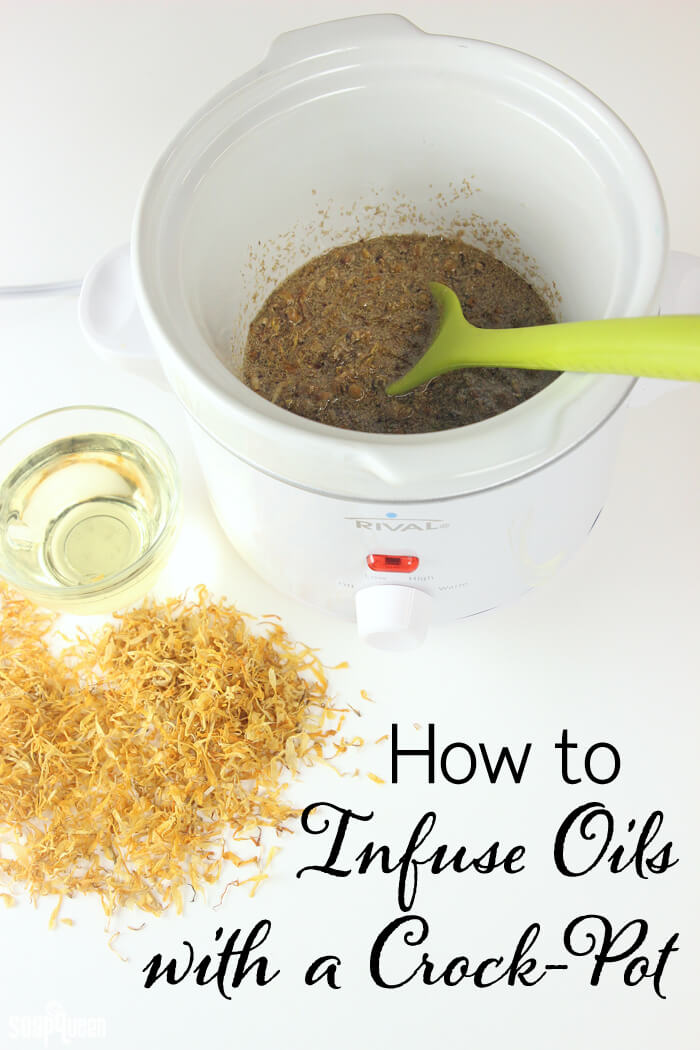
A simple handmade cold process soap is made up of oils, butters and sodium hydroxide lye. Various oils give handmade soap different properties, so each combination of oils will make a unique bar. Click here to learn more about the various properties of common soap making oils. To take your soap making oils to the next level, they can be infused with dried herbs such as lavender, chamomile, marigold and so many more. Infusing oils with herbs can add color, a light scent or skin-loving properties to your oil. If you’d like even more in-depth information on infusing oils including working with teas and clays, check out my E-Book Infusing: Herbs, Spices, Teas & Clays.
There are several different methods of infusing oils. These include infusing the oils on the stove top, in a Crock-Pot and cold infusion. When infusing oils with heat, such as on the stove or in a Crock-Pot, the process takes anywhere from 20 minutes to 4 hours. The time will depend on how hot your oils are and how concentrated you’d like the infusion to be. With cold infusion, herbs are added to room temperature oil and set aside for 4-6 weeks. If using the cold infusion method, be sure to use an oil with a long shelf life.
In addition to herbs, powders can also be infused into oil. Infusing powders in oil prevents speckles of powder that can occur when the powder is added directly to the soap. Popular powders for infusing include madder root powder, olive leaf powder, alkanet root powder and safflower powder. Indigo powder is an interesting ingredient, as it benefits from being added to reconstituted lye water rather than oils. The result is a darker, more intense blueish gray color.
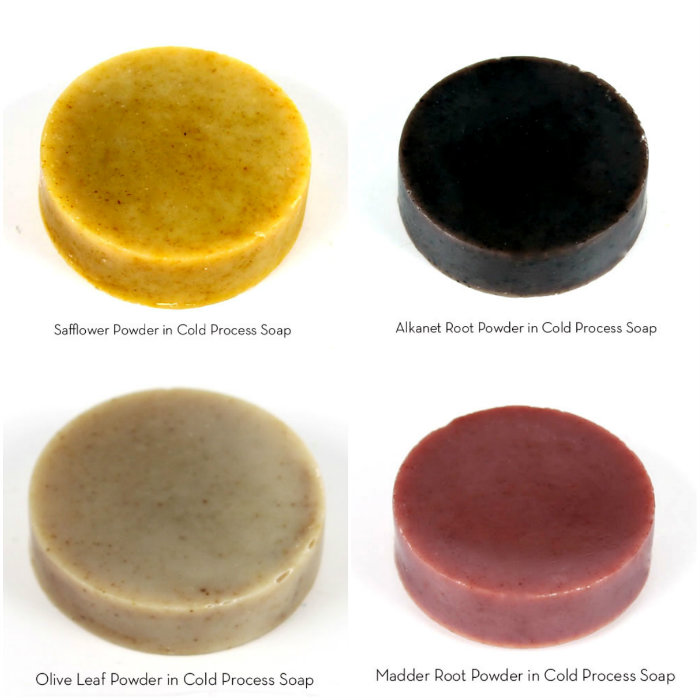 Top row: Safflower Powder, Alkanet Root Powder
Top row: Safflower Powder, Alkanet Root Powder
Bottom row: Olive Leaf Powder, Madder Root Powder
Common oils used for infusing include sweet almond, olive oil, avocado oil and chia seed oil, but almost any lightweight liquid oil can be used. When selecting your herbs, it’s best to use dried herbs. The moisture content of fresh herbs could promote mold and bacterial growth in your oil. Generally, hard oils such as coconut or palm are not infused, although they can be used if using the stove or Crock Pot method.
Infused oils can be used in cold process soap and other projects that include lightweight liquid oils. This includes bath bombs, massage oils, lotions, lip balm and scrubs. For example, calendula is infused in sweet almond oil in the Infused Lip Balm video on Soap Queen TV. For cold process soap specifically, it’s debatable if the skin-loving properties of herbs survive the saponification process, but it’s fantastic from a marketing and label standpoint. If you’re looking for more recipes using infused oils, check out the tutorials below!
Baby Massage Oil on Soap Queen TV
Sensuous Rose-Infused Massage Oil
Hot Oil Hair Treatment
I love using a Crock-Pot to infuse my oils because the temperature remains steady for long periods of time, and the bottom of the Crock-Pot will not burn the herbs. The amount of time it takes to infuse your oils will depend on your Crock-Pot. It will also depend on your personal preference. It’s important to remember that infusing oils is not a concrete science; the amount of oil and herbs used will depend on your recipe and how strongly you want to infuse the oil. In general, a good place to start is 1 tablespoon of herb per ounce of oil.
For this infusion, I’m creating a blend of both chamomile herbs and calendula petals. Both of these herbs are known for their gentle, skin-soothing properties. I’m using 16 oz. of sweet almond oil with 8 tablespoons of calendula petals and 8 tablespoons of chamomile herbs. Roughly, that was about .6 oz of chamomile and .2 oz of calendula. Place both the herbs and oils into the Crock-Pot, stir and set the Crock-Pot to low. If you’d like, you can add your herbs into a sealable tea bag. This extra step means you won’t need to strain the oils later.
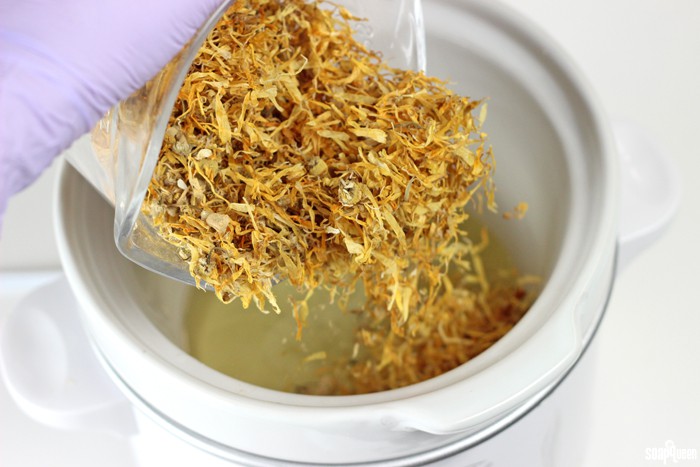
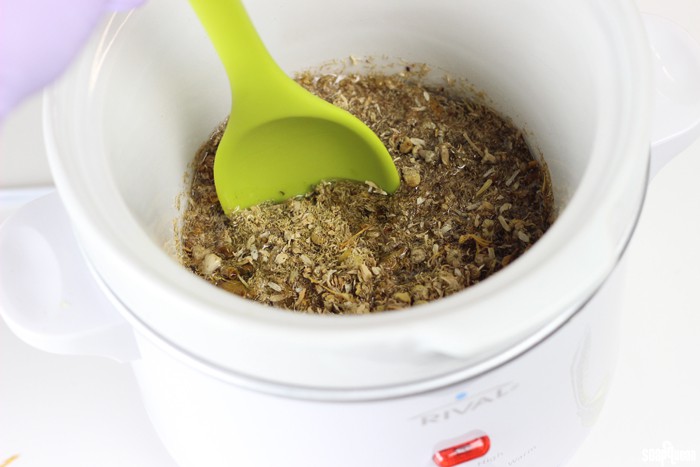 Cover the Crock-Pot with the lid and allow the oils and herbs “cook” for about 30 minutes. After that time, you may notice the oils start to slightly change color. At this point, you can strain the oils from the herbs, or you may choose to infuse them a little longer. I let my oils and herbs infuse for another hour to get all the benefits from the herbs.
Cover the Crock-Pot with the lid and allow the oils and herbs “cook” for about 30 minutes. After that time, you may notice the oils start to slightly change color. At this point, you can strain the oils from the herbs, or you may choose to infuse them a little longer. I let my oils and herbs infuse for another hour to get all the benefits from the herbs.
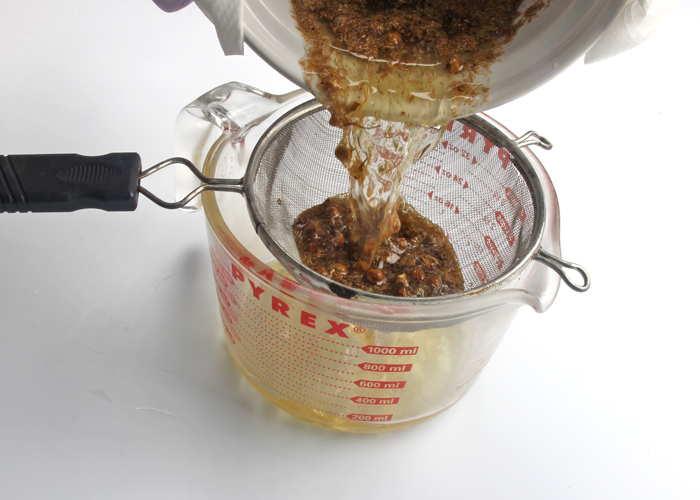 Once you are finished infusing the oils, allow them to cool slightly. Pour the oils through a strainer and into a heat safe bowl. If you find that small pieces of the herbs are still in your oil, you can pour them through a cheese cloth, coffee filter or thin paper towel to remove them.
Once you are finished infusing the oils, allow them to cool slightly. Pour the oils through a strainer and into a heat safe bowl. If you find that small pieces of the herbs are still in your oil, you can pour them through a cheese cloth, coffee filter or thin paper towel to remove them.
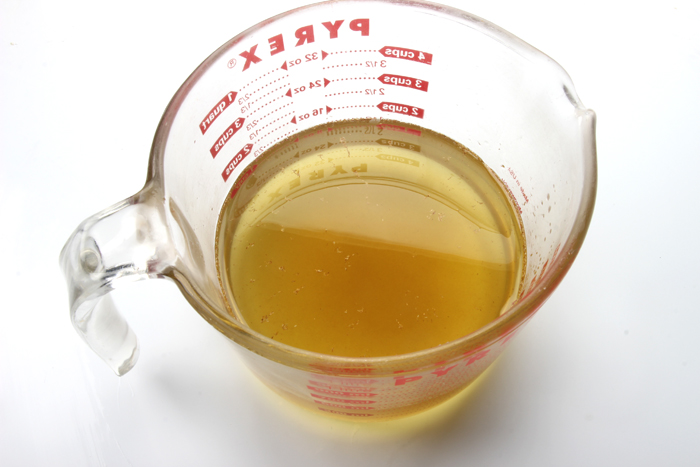 Transfer your oil into a sealable container and write the date in which it was infused. Store in a cool, dark place to ensure your oils last as long as possible. The shelf life of the infusion will be the same as the shelf life of your oil. Find shelf lives for common oils here. The oil can then be used as normal in your soap, lotions, balms and more.
Transfer your oil into a sealable container and write the date in which it was infused. Store in a cool, dark place to ensure your oils last as long as possible. The shelf life of the infusion will be the same as the shelf life of your oil. Find shelf lives for common oils here. The oil can then be used as normal in your soap, lotions, balms and more.
Curious about some more infusing options? The list below has a few common infusing herbs, and what they add to your soap. Do you have a favorite oil to infuse?
Common Infusing Herb Properties:
Alkanet Root Powder: Adds a grey-ish purple color to cold process soap.
Annatto Seed: Adds an orange tint to cold process soap.
Chamomile Herb: Known for its calming and soothing properties.
Indigo Powder: Gives soap a blue gray hue; we recommend reconstituting indigo powder in your lye solution.
Lavender Buds: Known for its relaxing scent.
Madder Root Powder: Gives a reddish color to cold process soap.
Marigold (Calendula): Known for its skin-soothing properties. Can give a slight yellow/orange tint to soap.
Olive Leaf Powder: Gives a greenish-grey color to cold process soap.
Rose Petals: Great for marketing; does not add much scent.
Safflower Powder: Gives a yellow hue to cold process soap.
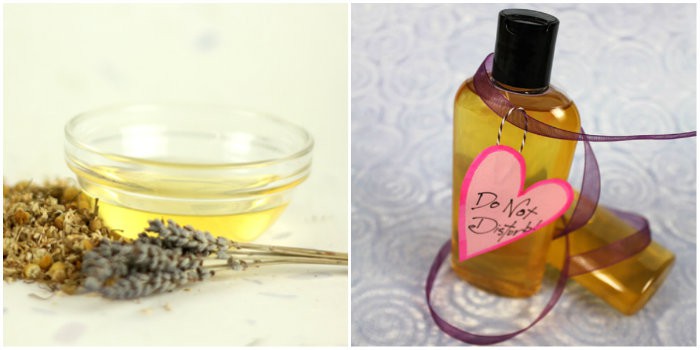
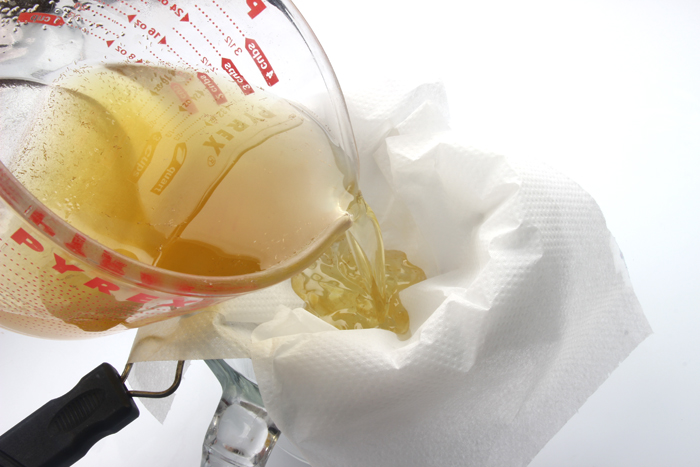




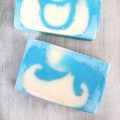
Hi,
I’m just starting to dabble in making essential oils, extracts, and soaps. Can you tell me what I can use my leftover herbs and flowers for, after I drain the oil/extract? And also do I have to drain them at all, or can I put them in the bottle I’m storing my oil/extract in? That way I can transfer a little at a time to small bottles.
Thank you for all the lovely information.
Yoyo😊
You can use those leftover herbs right in your soap! They add color and texture. We did that in one of our Soap Crafting recipes: https://www.brambleberry.com/Soap-Crafting-Book.aspx
As for leaving them in the bottles, some herbs do have a tendency to mold or turn brown in your oil. You may want to test a few to see how long they last in the oil. If they have a fairly short shelf life, you can strain them out and add them to your soap. 🙂
-Kelsey with Bramble Berry
Great! Thank you so much 😊
If i wanted to make a body oil and put dried calendula in the bottle (i like the look of it with the oils in the bottle) does it need a preservative? Thanks in advance! 🙂
That should be just fine! Over time the calendula may brown a bit, but it should have a fairly long shelf life. You won’t need a preservative. It helps protect against mold and bacteria from water, but won’t extend the shelf life of the calendula. So, I would recommend making a small test batch with just oil and calendula to see how long it lasts. 🙂
-Kelsey with Bramble Berry
For your baby massage oil recipe, can I use chamomile infused safflower oil in place of the sweet almond oil? Would it be safe on a 6 month old baby?
You can use safflower oil instead! Chamomile is fairly gentle on the skin. To be 100% sure, you may want to ask your doctor if that is safe on baby skin. That way you know if there are any potential irritants. 🙂
Baby Massage Oil: https://www.soapqueen.com/bath-and-body-tutorials/soaks-and-scrubs/baby-massage-oil-video/
-Kelsey with Bramble Berry
Can I infuse grocery store tea bags in oil? (Twinnings Chamomile or lavender for example?)
I think that would be OK! As long as they just have the chamomile and lavender and no other additives that may do odd things in the oil. You may try a small test batch just to be sure. 🙂
-Kelsey with Bramble Berry
Can I use the crock pot to infuse fresh plant materials? If so, how whould I go about doing this?
I would like to infuse rosemary with extra virgin olive oil do I need a preservative and I would like to store them in applicator bottles…do you think this would generate mold?
I also read you should soak the rosemary in vinegar before you start the process and then let it dry for a few days….do you recommend this?
That oil should store well with no mold! Make sure to strain it through several times so there are no bits of rosemary that can go brown. There is a very, very tiny chance the oil can mold, so store it in a cool, dry place to prevent that. It will last as long as the oil shelf life. 🙂
This post has more on oil shelf lives: http://www.soapqueen.com/bath-and-body-tutorials/tips-and-tricks/free-beginners-guide-to-soapmaking-common-soapmaking-oils/
We don’t typically soak the herbs in vinegar before infusing. Do you know why that’s done? Thanks!
-Kelsey with Bramble Berry
Hi what I’ve got are powdered herbs and fractionated coconut oil. How can I infuse them without getting in the sediments of the oils in.
Hi Judith!
After infusing the herbs in the Crock-Pot, you can use cheesecloth to help strain out any sediment! Cheesecloth helps catch little bits. You can also use a coffee filter if you don’t have cheesecloth on hand. 🙂
-Kelsey with Bramble Berry
I tried making my first infused calendula oil and my oil got to hot ( sweet almond oil) it fried my dried calendula……
Can I still use this oil or should I just get rid of it and start over? Asking as I made a large bottle of 32 oz…
Hi Christina!
I think that oil should be just fine to use! Oil is fairly sturdy, so even if the calendula got a bit hot the oil should be OK to add to your recipes. To be on the safe side, I would recommend a small test batch to see if you notice anything odd. 🙂
-Kelsey with Bramble Berry
Hi,
I was wondering, can you infuse oils for lip balms without the worry of it molding?
My friends mom told me she bought a lip balm and it molded, I am not sure what was all in it, but now I always research what I put in my lip balms.
Thanks!
Anna
Hi Anna!
When infusing oils, there is a very, very small chance they can mold. That is always the case with natural products! However, I can tell you we have infusions in our Soap Lab that are a year old and haven’t molded. To ensure it stays mold free, we recommend using dried herbs and storing the oil in a cool, dry place. 🙂
-Kelsey with Bramble Berry
HI,
Is it possible to use infused oil in liquid (potassium) soap making also?
Absolutely! Infused oil would feel great in liquid soap. Depending on what herb you use, it can also tint the color of the soap slightly. For instance, calendula oil may give your soap a light golden hue. 🙂
-Kelsey with Bramble Berry
Do I always have to strain the herb out? I was going to add ground herb into my soap. Can I just mix them up and put it in the soap?
Hi Angela!
You can leave the herbs in if you like! Because herbs are a natural product, they can turn brown in the soap. That’s something to keep in mind. 🙂
-Kelsey with Bramble Berry
I have been studying on numerous websites about Calendula-infused oils. I made some lotion out of the first batch of oil that I made and it has been really good for my mother’s skin issues. I just made a second batch of oil and then I found an article about adding preservatives in the oil after straining the marigold flowers out. My question is about the preservative and if it is needed at the oil stage. I read your webpage about preservatives being needed in any recipe that includes water… so I am assuming the Calendula oil doesn’t need preservative until it is put in a recipe. I just wanted to confirm the infused oil doesn’t need preservative.
I love your website and will be linking to some webpages from my website. Thanks for teaching us!!
Hi Stacy!
That’s awesome, so glad those infused oils are working well for your mom! I love infusing oils.
Also, you are correct – the infused oil itself doesn’t need a preservative, as there is no water in the mix. However, when that oil is added to water to make a lotion, it will need a preservative to protect against mold and bacteria. 🙂
-Kelsey with Bramble Berry
Talk It Out Tuesday: Preservatives: http://www.soapqueen.com/bath-and-body-tutorials/lotion/talk-it-out-tuesday-preservatives/
Hello,
Can you infuse the oils that will be saponified or do you only add the infused oil to the soap at trace? Does lye will react or remove the benefits of the herbs?
Thank you for all the information you share!
Hi Ginny!
You can add that infused oil to your main batch of oils before the lye is added, or you can add them at trace! Either way would work just fine. 🙂
It’s tough to say whether the herb properties make it through saponification. All the pH changes make it a fairly rough environment. However, infused oils can add a subtle color and are great from a marketing standpoint!
-Kelsey with Bramble Berry
I love to infuse oils to use in my projects. Calendula is one of my favorites. But I have had bad luck with the crockpot method. I have burned my infusion twice now. I let it go for about an hour and then noticed this funny smell, which turned out to be deep fried chamomile flowers. I tried it again with some comfrey root and the same result. Perhaps my crockpot runs hot even on the low setting, I’m not sure. So, since I live in a sunny climate, I now infuse my herbs in the sun for 3-7 days. Works beautifully in the warm months. I just did batches of rosemary, plantain, lemon balm, calendula and chamomile. And none of them burnt.
Infusing your herbs in the sun is a great method! It sounds like a nice gentle way to infuse them. 🙂
Also, my Crock-Pot at home has a high, low and warm setting. Putting the Crock-Pot on a warm setting may prevent them from burning!
-Kelsey with Bramble Berry
Thanks Kelsey, but my point is that infusing Madder Root did nothing for me. I still had to use actual powder to get good color, which is fine. I also like the speckles and the scratchines, and I will use it again. But only straight powder dispersed in some oil. I won’t bother with infusions again. 🙂
As for Indigo, I did CPOP, so it definitely gelled. And it looks fine, tiny bit speckle-y, only it’s not blue at all, just gray. I used 1 tsp on 3lb soap.
I’ll try using a lot less next time though, so we’ll see.
Absolutely, I actually add the madder root straight to my soap as well. I like that color better. 🙂
Have fun soaping with the indigo powder!
-Kelsey with Bramble Berry
How does this change your labeling? Not sure how you would label the oil once infused on the ingredient list
That’s a really good question, and one I hadn’t considered.
Hi Kim!
There are several ways you could label the infused oil in your product! An example is to write “infused oil (olive oil, calendula).” You can also list the oil and herb like normal – from most used to least used in your ingredient list. While the herb is strained out, its properties are still in the oil and is important to people who may have allergies or sensitivities. 🙂
-Kelsey with Bramble Berry
How to Label Cold Process Soap: http://www.soapqueen.com/bath-and-body-tutorials/cold-process-soap/how-to-label-cold-process-soap/
Thank You! I came to this page to ask this precise question!
Also wanted to say that I love the idea of using a tea bag to put the herbs in, really makes the whole idea of infusing so much faster and easier!
And just a thought, I always used a bain marie set up to infuse, and recently moved that into the crock pot, for anyone worried about scorching oils right in the pot it is a way to make use of the gentle steady heat the crock pot gives but without having the oil in direct contact with the heat. Just figured I’d share.
Thanks again,
Grey Dove
That’s awesome, so glad we could help you out! Also, thanks so much for sharing your awesome tip. 🙂
-Kelsey with Bramble Berry
I love all your articles you guys are brilliant. I have a question what is the difference between almond oil and sweet almond oil for use in soaps. Sorry if it’s a stupid question
So glad you love the articles Jackie! Also, no worries – that is a great question. 🙂
Bitter almond oil is typically used in products for its scent and taste, while sweet almond oil is used for adding moisturizing properties. Bitter almonds contain cyanogenic glucoside amygdalin, which produces cyanide. Use bitter almond oil with extreme caution.
You can read more in the Sunday Night Spotlight: Sweet Almond Oil: http://www.soapqueen.com/bramble-berry-news/sunday-night-spotlight-sweet-almond-oil/
-Kelsey with Bramble Berry
Very good information!
So far, I only infused Madder Root, but I don’t think it works good. Can’t remember the measurements, but I followed your directions, and I still didn’t get much color change in it. I did it with olive oil. The powder just settled on the bottom, even after heating and stirring a few times.
When I made my soap, I used it as the full amount of olive oil in my recipe. When I added lye, the whole thing turned brown!!! I quickly added TD to it to lighten it. I was hoping for pink color as I was using English Rose FO. It was still brownish/tan color. Then I divided it and added some of the madder root from the bottom of the container to one part, some Merlot mica to the other, and left the rest that weird color. At the end, this is what happened: that tanish color became like an ivory color with a pinkish tint, merlot mica became nice pink, and the root part became nice darker pink/red color. And it definitely feels scratchy on skin from the root. It came out pretty nice at the end with a lovely swirl (FO gave me no trouble). 🙂
I also used indigo powder once, directly in lye, and, while it worked great, it is completely gray, no blue at all. It is also very, very strong! I’ll try not putting it in lye next, hopefully I’ll get some blue, and not just gray.
I just ordered alkanet, so we’ll see how that one goes.
Hi Martina!
So glad the soap turned out well for you! Your layered soap sounds beautiful. 🙂
We found that even when madder root was mixed with oil before adding to soap, it did have a few speckles. That is just the nature of the natural colorant! I think the speckles add a beautiful touch. You can read more in the Mad About Madder Root post: http://www.soapqueen.com/bath-and-body-tutorials/tips-and-tricks/using-madder-root-powder-color-soap/
Natural indigo powder typically creates a grayish blue color in your soap. To bring out more of the blue tones, we recommend gelling your soap. Typically, gel phase helps make natural colors more vibrant. 🙂
Jazzed About Gel Phase: https://www.brambleberry.com/Natural-Indigo-Powder-P5727.aspx
Natural indigo powder: https://www.brambleberry.com/Natural-Indigo-Powder-P5727.aspx
Have fun trying more natural colorants in your soap!
Alkanet root: https://www.brambleberry.com/Alkanet-Root-Powder-P4012.aspx
-Kelsey with Bramble Berry